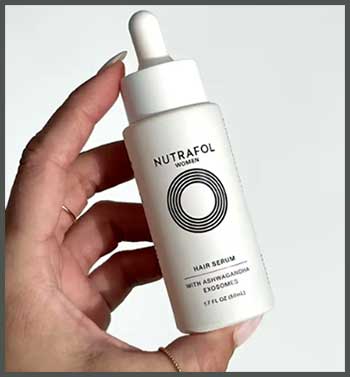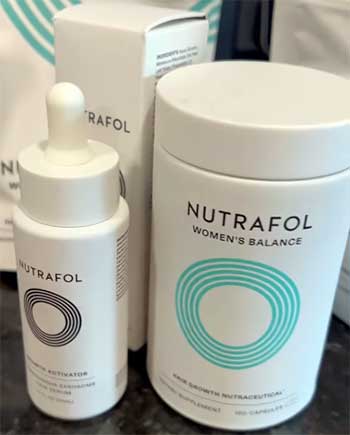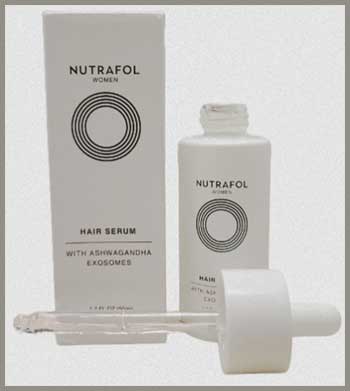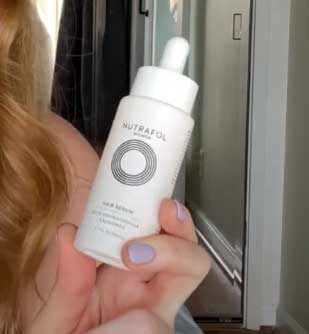I’ve been curious about Nutrafol for a while now, ever since I noticed my hair thinning and started hunting for solutions. The brand’s sleek packaging and bold claims about tackling hair loss caught my eye, but so did the price tag—$80 a month for a bottle of supplements?
That’s no small change. In this article, I’m unpacking why Nutrafol costs so much, breaking down the factors behind its premium price, and exploring whether it’s worth it for you.
From ingredients to marketing, let’s figure out what you’re really paying for.
My First Encounter With Nutrafol

Picture this: I’m scrolling through Instagram, and there’s another glossy ad for Nutrafol, promising thicker, fuller hair.
The before-and-after photos are impressive, and the comments are buzzing with people swearing it’s their “holy grail.”
But when I checked the price, my jaw dropped—$80 for a 30-day supply of 120 capsules, taken four a day.
That’s like buying a fancy dinner every month just for my hair. I had to know: what makes Nutrafol so pricey?
Is it the gold standard of hair supplements, or just clever branding? I started digging, and here’s what I found.
Premium Ingredients: Quality Comes at a Cost
One of the first things I noticed about Nutrafol is its ingredient list. It’s not your average biotin supplement from the drugstore. Each capsule is packed with a blend of botanicals, vitamins, and minerals designed to tackle hair thinning from multiple angles.
Think saw palmetto, ashwagandha, curcumin, and marine collagen—ingredients that sound like they belong in a high-end smoothie, not just a pill.
Take saw palmetto, for example. It’s a plant extract that may block dihydrotestosterone (DHT), a hormone linked to hair loss. Studies suggest it can reduce hair thinning, but it’s not cheap to source sustainably or in high-quality forms.
Then there’s ashwagandha, an adaptogen that helps manage stress, which Nutrafol claims can indirectly support hair health by lowering cortisol levels. These aren’t your run-of-the-mill vitamins; they’re specialized, often requiring careful extraction and processing to maintain potency.
Nutrafol also includes marine collagen, which is pricier than standard collagen because it’s derived from fish. It’s touted for improving hair strength and scalp health, but the sourcing process—ensuring it’s free of contaminants like heavy metals—adds to the cost.
Add in other ingredients like tocotrienols (a form of vitamin E), resveratrol, and kelp, and you’ve got a formula that’s complex and expensive to produce.
I compared it to a basic biotin supplement, which might cost $10 for 60 pills, and the difference is clear: Nutrafol’s blend is more like a curated health cocktail than a single-note vitamin.
The company emphasizes that its ingredients are sustainably sourced and tested by third parties for purity. That’s reassuring, but it’s not free.
Sourcing from certified facilities, ensuring no harmful chemicals or fillers, and maintaining gluten-free, dairy-free, and hormone-free standards all drive up production costs. I get it—quality isn’t cheap—but I wondered if every ingredient was essential or if some were there to make the label look impressive.
Research and Development: Science Isn’t Free

Nutrafol doesn’t just throw ingredients together and call it a day.
The brand invests heavily in research, which is a big reason for its price.
I found studies, like one published in the Journal of Drugs in Dermatology in 2021, showing that Nutrafol’s Women’s formula increased hair counts by 32.41% after 180 days compared to a placebo. That’s promising, but clinical trials aren’t cheap.
They involve recruiting participants, hiring researchers, and using advanced tools like phototrichograms to measure hair growth.
The company also employs naturopathic doctors and scientists, like Dr. Sophia Kogan, one of its co-founders, to develop and refine its formulas.
These experts tailor products to specific needs—men, women, postpartum, and menopausal formulas all have slightly different ingredient profiles.
For example, Women’s Balance includes maca root to support hormonal changes during menopause, while the Men’s formula has a higher dose of saw palmetto for DHT-related hair loss. This level of customization requires time and expertise, which adds to the cost.
I also learned that Nutrafol’s parent company, Nutraceutical Wellness, sponsors its own trials. While this raises questions about bias—more on that later—it still means they’re spending money on science, unlike some brands that rely on anecdotal claims.
The downside?
You’re footing the bill for those studies every time you buy a bottle.
Manufacturing Standards: Made in the USA
Where a product is made matters, and Nutrafol’s supplements are produced in the United States at facilities that meet strict regulatory standards. I looked into this, and it turns out that U.S.-based manufacturing is pricier than outsourcing to countries with lower labor costs.
These facilities are certified to follow Good Manufacturing Practices (GMP), ensuring consistency and safety in every batch.
This isn’t just about slapping a “Made in the USA” label on the bottle. It involves regular inspections, high-quality equipment, and trained staff, all of which cost money.
Compare that to some generic supplements made overseas with less oversight, and you can see why Nutrafol’s production expenses are higher. I appreciate the transparency, but it’s another factor pushing up the price you and I pay.
Marketing and Branding: The Power of Perception

Let’s be real: Nutrafol’s marketing is everywhere.
From Instagram ads to influencer endorsements, the brand has a massive presence.
I’ve seen celebrities and hairstylists raving about it, and that kind of visibility doesn’t come cheap.
The company reportedly spends millions annually on platforms like Facebook, YouTube, and Instagram, according to some reviews I read.
Those marketing dollars? They’re built into the cost of every bottle.
Nutrafol’s branding is sleek and professional, positioning it as a premium, science-backed solution. The glass bottles, minimalist design, and polished website scream “luxury.”
I compared this to a budget brand like Folexin, which has simpler packaging and less aggressive advertising, and it’s no surprise Folexin costs about $24 a month. Nutrafol’s heavy investment in creating a high-end image means you’re paying for more than just the pills—you’re buying into a lifestyle.
There’s also the influencer effect. When I saw my favorite beauty blogger praising Nutrafol, I was tempted to try it. But influencers don’t promote products for free, and those sponsorships add to the brand’s expenses.
It’s effective—Nutrafol’s Trustpilot page has glowing reviews from thousands of customers—but it’s another reason the price is so steep.
Clinical Claims and Controversy
Nutrafol loves to tout its “clinically proven” status, but I dug deeper and found some nuance. The studies, while promising, have limitations. For one, they’re sponsored by Nutrafol’s parent company, which could introduce bias.
The 2021 study I mentioned earlier focused on women with self-perceived thinning, not necessarily those with advanced hair loss or male pattern baldness.
I also found a complaint filed by Truth in Advertising in 2023, accusing Nutrafol of deceptive marketing for overstating its clinical claims without FDA approval.
This got me thinking: am I paying for results or hype? The studies show modest improvements—better hair density and less shedding—but they’re not game-changers for everyone.
If you have severe hair loss, Nutrafol might not cut it compared to FDA-approved treatments like minoxidil or finasteride, which are often cheaper. Still, the brand’s emphasis on science, even if imperfect, sets it apart from competitors, and that research investment contributes to the cost.
Customization and Product Range
Nutrafol doesn’t offer a one-size-fits-all pill. Instead, it has targeted formulas: Women’s, Men’s, Women’s Vegan, Postpartum, and Women’s Balance for menopausal women.
Each has a unique blend tailored to specific causes of hair loss, like hormonal changes or stress. For example, the Postpartum formula includes theanine and shatavari to support new moms, while the Men’s formula focuses on DHT inhibition.
This customization is a double-edged sword. On one hand, it’s great to have options that address your specific needs—I took their online quiz and got recommendations for Women’s and a Hairbiotic booster.
On the other hand, developing multiple formulas means higher R&D and production costs. You’re not just buying a supplement; you’re paying for a personalized approach, which Nutrafol bets you’ll value enough to justify the price.
The brand also offers boosters, like the DHT Inhibitor or Hairbiotic, which can bump up the cost even more. A Hair Growth Duo (main supplement plus a booster) can run $100 or more per month. I like the idea of a tailored regimen, but it’s easy to see how the expenses add up.
Packaging and Presentation
I have to admit, Nutrafol’s packaging is gorgeous. The heavy glass bottle feels luxurious, and the sturdy box it comes in makes you feel like you’re unboxing something special. But as one Trustpilot reviewer pointed out, this fancy packaging isn’t necessary.
They suggested reusable bottles or simpler shipping materials to cut costs, and I agree. Why am I paying for a box that’s just going into the recycling bin?
The premium presentation reinforces Nutrafol’s high-end image, but it’s not free. Producing glass bottles, designing custom boxes, and ensuring everything arrives in perfect condition adds to the price.
Compare that to a brand like Viviscal, which uses plastic bottles and costs about $40 a month, and you can see where some of your money is going.
Subscription Model and Customer Support

Nutrafol encourages subscriptions, which can lower the monthly cost to around $60 if you buy in bulk (e.g., six months at a time).
This saves money, but it’s still a commitment.
I also noticed that subscribers get perks like one-on-one consultations with naturopathic doctors and hair mineral analyses after six months.
These services sound valuable, but they’re not cheap to provide.
Customer support is another factor. Nutrafol offers access to experts who can guide you through their products, which is great if you’re unsure which formula to choose. But maintaining a team of professionals—plus handling returns, refunds, and shipping—adds overhead.
Some reviews on Trustpilot complained about subscription issues, like unexpected charges, which made me wary. Still, the personalized support is part of what you’re paying for, even if it’s not perfect.
Comparing Nutrafol To Alternatives
To understand Nutrafol’s price, I compared it to other hair growth supplements. Folexin, for example, costs about $18-$24 per month and includes similar ingredients like biotin, saw palmetto, and zinc.
However, it lacks the extensive botanical blend and clinical studies that Nutrafol offers. Viviscal, another popular option, is around $40 a month and has its own research backing its marine-based formula, but it’s less customizable.
Then there’s the DIY approach. I could buy individual supplements—like saw palmetto, ashwagandha, and a multivitamin—for less than Nutrafol’s price.
But as one GQ article pointed out, once you add up the cost of sourcing high-quality versions of these ingredients, Nutrafol’s all-in-one formula starts to look more reasonable. Still, if budget is a concern, these alternatives are worth considering.
The Holistic Approach: More Than Just Hair
One thing I appreciate about Nutrafol is its holistic philosophy. It doesn’t just promise hair growth; it aims to improve overall wellness by addressing stress, hormones, and nutrition.
For example, the Women’s formula includes iodine and selenium to support thyroid health, which can impact hair. The Postpartum formula targets emotional stress with ingredients like theanine, which I found intriguing as a new mom.
This “whole-body” approach makes Nutrafol feel like more than a beauty product—it’s almost like a wellness supplement with hair benefits. But that broader focus means you’re paying for ingredients that might not directly affect your hair.
I wondered if I could get similar benefits from a cheaper multivitamin, but Nutrafol’s targeted blend is hard to replicate without spending time and money on individual supplements.
Potential Downsides: Is It Worth It?
Not everyone loves Nutrafol. Some reviews I read on Reddit and Trustpilot mentioned no results after months of use, which is frustrating at $80 a pop.
Others reported mild side effects like nausea or bloating, possibly due to high doses of vitamins or ingredients like kelp, which can affect thyroid function if overconsumed. The four-pills-a-day regimen is also a hassle—swallowing them all at once feels like a chore.
Then there’s the time factor. Nutrafol says results take three to six months, so you’re looking at $240-$480 before you might see a difference.
If your hair loss is genetic or advanced, Nutrafol may not be enough, and you might need treatments like minoxidil or a hair transplant, which could be more cost-effective long-term. I also found that vegans and those with fish allergies can’t use most formulas due to marine collagen, which limits its appeal.
My Experience: Did It Feel Worth the Price?
I decided to try Nutrafol’s Women’s formula for three months to see if it lived up to the hype. The first month was uneventful—my hair didn’t magically thicken, but I didn’t expect it to.
By month two, I noticed less shedding when I brushed my hair, and by month three, my hairstylist commented that my hair felt denser. Was it worth $240? I’m not sure. The results were subtle, and I couldn’t help but wonder if a cheaper supplement would’ve done the same.
What stood out was how Nutrafol made me feel proactive about my health. Taking four pills a day became a ritual, and the idea that I was addressing stress and hormones alongside hair loss was empowering.
But when I crunched the numbers, I realized I could’ve bought a year’s worth of Folexin for the same price, which gave me pause.
The Verdict: Why You’re Paying a Premium
So, why is Nutrafol so expensive? It’s a combination of high-quality, sustainable ingredients, extensive research, U.S.-based manufacturing, aggressive marketing, and a premium brand image.
The customized formulas, luxurious packaging, and customer support add even more to the cost. You’re not just buying a supplement—you’re investing in a science-backed, holistic approach to hair health, complete with a glossy lifestyle.
Is it worth it for you?
That depends. If you value natural ingredients, are willing to wait for results, and can afford $60-$80 a month, Nutrafol might be a game-changer. But if you’re on a budget or need faster, more proven results, alternatives like Folexin, Viviscal, or FDA-approved treatments might be smarter.
I’ve learned that hair loss is personal—what works for one person might not for another. You’ve got to weigh the cost against your goals and decide if Nutrafol’s premium price fits your life.
Frequently Asked Questions (FAQ)
Yes, supplements like Folexin ($18-$24/month) or Viviscal ($40/month) offer similar ingredients at a lower cost, though they may lack Nutrafol’s extensive blend or research.
Downsides include its high cost, four-pill daily dose, potential mild side effects (nausea, bloating), and limited effectiveness for advanced or genetic hair loss.
Some dermatologists recommend Nutrafol for its natural ingredients and studies, but others note limited independent research and suggest FDA-approved treatments for severe cases.
No, insurance typically doesn’t cover Nutrafol, as it’s a dietary supplement, not a prescription medication.
Wrapping Up
I’ve spent hours researching and even tried Nutrafol myself to understand why it’s so expensive, and now you know the full story.
From its premium ingredients and clinical studies to its slick marketing and fancy packaging, Nutrafol’s price reflects a carefully crafted brand that promises more than just hair growth—it’s about wellness and confidence.
Whether you choose to invest in it or explore cheaper alternatives, you’re now equipped to make an informed decision. Your hair journey is unique, so pick what aligns with your budget and goals—you’ve got this!
